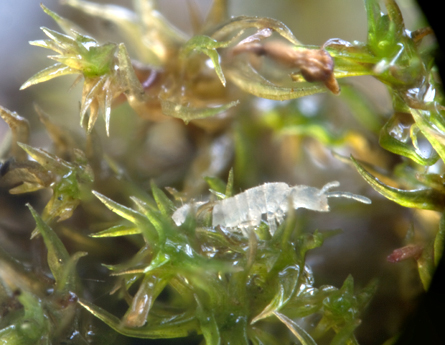Mosses really may be getting a reproductive boost by luring tiny animals to deliver plant sperm.

Male moss plants don’t make pollen, but instead send sperm off to try to swim through dew to find a female moss. Earlier research in dry lab containers showed that the sperm can hitchhike on mites and little arthropods called springtails. “The question was, but do they?” says Sarah Eppley, an evolutionary ecologist at Portland State University in Oregon.
Now, lab tests with two moss species show that in more natural, dewy conditions, springtails increased moss fertilization. With water alone, sperm found female moss in roughly a third of moss test clumps, but water plus springtails raised the number to almost half, Eppley and her colleagues report online July 18 in Nature.
The new paper improves the case for springtail sperm delivery, says evolutionary bryologist Nils Cronberg of Lund University in Sweden. His earlier work had suggested that little animals follow odor to mosses, and the new tests reveal that fertile moss shoots in fact emit many scent compounds — and strengthens the case that scent guides springtails to those fertile shoots.
Females and males of the widespread moss Ceratodon purpureus release different blends of scent compounds, Eppley and her colleagues report. In the team’s odor chambers, springtails preferred the scent of the female mosses to the whiff of a male. Floating sperm may snag onto the springtails wading through dew, and as the animals investigate a female moss’s intriguing smell, they inadvertently deliver the hitchhiker sperm.
One puzzling aspect of the new study is that scent ingredients varied more among the female mosses than among the males, says Robert Raguso of Cornell University. That variation may suggest that the female mosses aren’t particularly pressured by evolutionary forces, or are deceiving or otherwise confounding animal sperm-couriers.
It’s not yet clear what the springtails might be getting out of this arrangement. Eppley notes that reproductive mosses can ooze sugary droplets, which little animals might fancy. There are other possible rewards, Raguso says. Springtails are tiny, so “mosses could be entire forests to these critters” and provide breeding habitat, escape from predators or any number of other services.
Although fertilization tests have taken place only in two species, Eppley predicts the phenomenon could be widespread. She’s examined moss sperm, and, she says, “they are terrible swimmers.”





